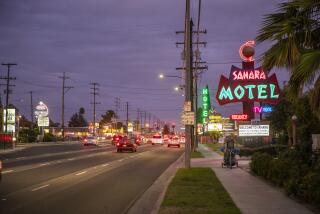CLIPBOARD
- Share via
In northwest Stanton, the tracks of the Southern Pacific railway cut a thin line between the haves and have-nots.
North of the tracks, 40-year-old housing was demolished to make way for condominiums and apartments. The buildings have replaced a schoolhouse and strawberry fields. Strip centers cater to the needs of a commuting populace.
Redevelopment has drawn new Stantonites into this densely populated area that, at the turn of the century, was the planned center of the community.
Capt. Bob Eason, a 20-year veteran with the Stanton Police Department, has collected a hodgepodge of oral history from longtime residents.
“Back in the early 1900s, Main Street was going to be the center of town, but the street didn’t travel more than a few blocks,” Eason said. “I don’t know where they planned to put the rest of the town.”
The “rest of the town” didn’t amount to much. Fields of sugar beets dotted the flat plain. Running past migrant worker housing, Beach Boulevard was a dusty cattle trail to La Mirada. This was a frontier town and Latino community with its share of feuding farmers and stubborn landowners.
“When you look at the area between Katella and Cerritos avenues, this is old Stanton,” Eason said. “For 60 years, the Benedict tract housed the migrants who worked the surrounding fields.”
There is more than one accounting of how the tract--the area bordered by Beach Boulevard and Katella, Cerritos and Western avenues--received its name. The version most accepted harks back to a dispute between a major landholder, the Barter family, and officials of the Southern Pacific Railroad.
According to a 1937 federal Works Progress Administration report that documented Stanton’s history, the tract was named after Benedict Arnold by the patriarch of the Barter family.
Land was donated by Doc Barter to Southern Pacific, giving the trains right of way through his property. In return, the railway agreed to build a depot on Barter’s land. Instead, the depot was built on the property of wealthy entrepreneur Philip Stanton. Barter dubbed the land “his Benedict deal,” and nicknamed the railroad depot Benedict Station. The tract name stuck, but so did Stanton’s.
The city first incorporated in 1911, to prevent annexation by Anaheim, which wanted to create a sewer farm on Stanton’s land. Stanton, who was also a member of the state Assembly from 1903 to 1909, led the fight against the annexation.
By 1924, the threat no longed existed and the city of Stanton returned to an unincorporated status to allow the state to build roads in the area.
Not until Orange County’s population boom in the late 1950s did the citizenry of Stanton decide to preserve local control by incorporating again.
In the early 1960s, north of the railroad tracks, homes replaced strawberry fields and, south of the tracks, street gangs replaced migrant workers.
“Years ago, every house had a picket fence for looks and safety,” said a local resident who wished not to be identified. “Today, we lock ourselves behind thick metal bars, but that doesn’t keep the gangs off the streets . . . it keeps us off the streets.”
Latino gangs have been present in the old neighborhood since the early 1960s. The gang claiming the Benedict tract as its turf is called Big Stanton by law enforcement agencies. “We use Big Stanton and Little Stanton to differentiate between two neighboring gangs,” Eason said. “But members of the Big Stanton gang call themselves Stantone. “
Graffiti-covered street signs, sidewalks and sound walls deface the barrio.
“Graffiti is in the old neighborhoods even if there isn’t a gang,” Eason said. “With all the (marker pens) available, kids just carry them in their pockets. Ironically, graffiti is an expression of a sense of pride of who you are and where you come from.”
It would seem that the gang activity of the Benedict tract would spill across the tracks into the lives of the young middle-class condominium dwellers, but that doesn’t seem to be true.
“I bought a house on Flower Street that my daughter lived in,” said Dick Matyus, a local real estate agent. “She loved it there and never had any problems with crime. Maybe on a Saturday night you might hear a couple of gunshots, but the gangs aren’t out to get more land. They just want to let other gangs know where their turf is.”
And, according to Eason, the crime rate in this area of Stanton is no higher than any other city in the county. In the highly populated area, burglary is the highest reported crime. However, Eason said most burglaries are committed by friends and neighbors, not by gangs.
“Burglary is a problem associated with living in densely populated apartment buildings,” Eason said. “Only those around you, the people who can watch your schedule, can get in and out of your home quickly. There seems to be little fear of getting caught.”
While gangs have given Stanton a negative image, there is a positive side too. The City Council’s emphasis on redevelopment and the rejuvenation of business along Beach Boulevard have boosted local residents’ affection for their hometown.
Northwest Stanton has progressed and changed. New businesses and housing equate to economic strides for the city and the Benedict tract’s residents cherish their neighborhood and its link to Stanton’s roots.
Population Total: (1990 est.) 5,369 1980-90 change: +11.4% Median Age: 30.7
Racial/ethnic mix: White (non-Latino): 53% Latino: 36% Black: 1% Other: 10%
By sex and age: MALES Median age: 29.3 years FEMALES Median age: 32.3 years
Income Per capita: $17,700 Median household: $39,243 Average household: $45,792
Income Distribution: Less than $25,000: 28% $25,000-49,999: 38% $50,000-74,999: 21% $75,000-$99,999: 8% $100,000 and more: 5%
More to Read
Sign up for Essential California
The most important California stories and recommendations in your inbox every morning.
You may occasionally receive promotional content from the Los Angeles Times.













